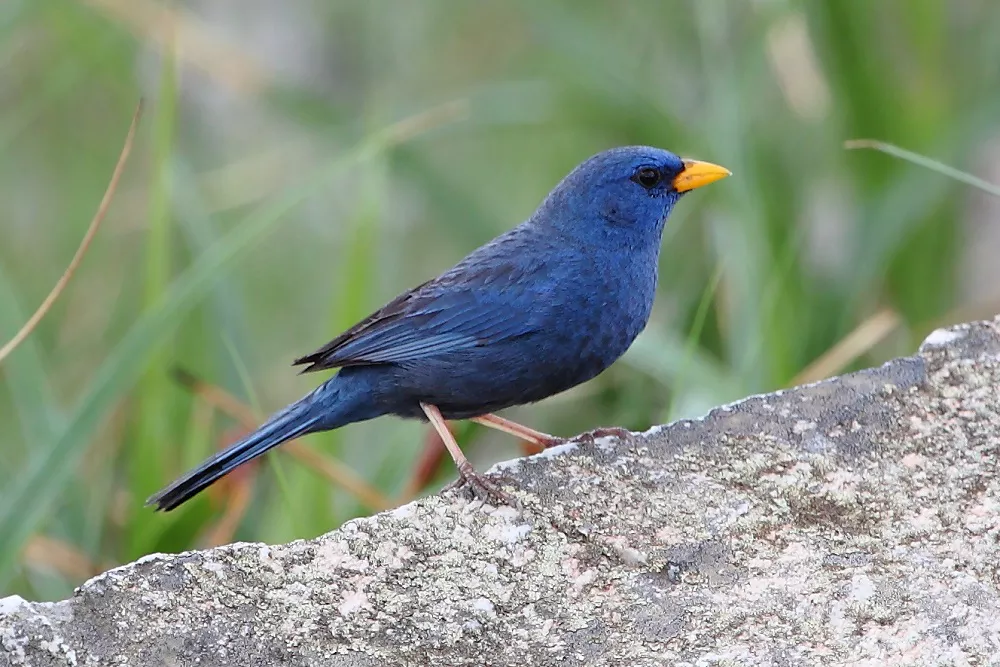When it comes to nature’s vibrant and diverse avian species, the blue finch stands out as a delightful sight. With its enchanting coloration and graceful movements, this small bird captures the attention of birdwatchers and nature enthusiasts alike. In this article, we will explore the physical characteristics, plumage, and behavioral traits of the blue finch, offering a comprehensive guide to understanding this captivating creature.
1. Physical Appearance
The blue finch, scientifically known as Passerina cyanea, belongs to the family Cardinalidae. This species exhibits pronounced sexual dimorphism, where males and females differ significantly in their physical appearance.
Size and Shape:
On average, blue finches measure around 4.5 to 5 inches (11-12 cm) in length. They possess a compact body with a short tail and a rounded head. Their beak is conical and slightly curved, allowing them to feed on seeds and insects.
Male Blue Finch:
The male blue finch sports a striking combination of bright blue plumage on the upperparts, head, and throat. The feathers are glossy, showcasing different shades of blue depending on the subspecies. The wings and back are darker, providing a contrasting effect to the vibrant blue hues. Additionally, they have black eyes and legs.
Female Blue Finch:
Unlike their male counterparts, female blue finches have a more subtle appearance. They exhibit a predominantly brownish-gray coloration across their body, with hints of blue on their wings and tail. The females also have light streaks and speckles on their underparts, helping them blend into their surroundings for better camouflage while nesting.
2. Plumage Variation
The blue finch species displays subtle variations in plumage coloration across different regions.
Eastern Blue Finch:
The eastern blue finch, found in the eastern United States and Canada, exhibits vibrant sky-blue plumage on its upperparts, head, and throat. Its belly and undertail coverts are white, while the wings and back are a darker shade of blue.
Western Blue Finch:
The western blue finch, primarily residing in the southwestern United States and northern Mexico, showcases a stunning turquoise-blue coloration. It has a distinct blue cap on its head, with a lighter blue extending across the back and wings. The belly and undertail coverts are white.
Mexican Blue Finch:
The Mexican blue finch, native to Central Mexico, demonstrates a rich cobalt-blue plumage. It possesses a black mask around its eyes, which contrasts beautifully with its blue body. The wings and back are slightly darker, while the belly and undertail coverts remain white.
3. Behavior and Habitat
The blue finch is an arboreal species that thrives in diverse habitats throughout its range.
Feeding Habits:
Blue finches primarily feed on seeds, berries, and insects. They forage in trees and shrubs, using their sharp beaks to extract food from various sources. Observing them in their natural habitat can provide insights into their feeding behavior and dietary preferences.
Breeding and Nesting:
During the breeding season, male blue finches engage in elaborate courtship displays to attract females. They sing melodious songs and perform aerial acrobatics to demonstrate their fitness as potential mates. The female constructs a cup-shaped nest made of twigs, grass, and other plant materials. She lays a clutch of 3-4 eggs and incubates them for about two weeks until they hatch.
Migration:
Blue finches exhibit partial migration patterns, with some populations migrating to warmer regions during winter. However, the extent of migration varies among subspecies and individuals. Understanding their migratory behavior and routes is crucial for conservation efforts.
4. Conservation Status:
The blue finch population is generally stable, but certain factors pose threats to their sustainability.
Habitat Loss:
Deforestation, urbanization, and the destruction of natural habitats have a significant impact on blue finches. Clearing forests deprives them of nesting sites and reduces food availability.
Climate Change:
Alterations in climate patterns affect the availability of food sources and disrupt nesting cycles. These changes can potentially influence the distribution and abundance of blue finch populations.
Conservation Efforts:
Protecting and conserving suitable habitats, implementing sustainable land management practices, and raising awareness about the importance of preserving these avian species are vital steps toward safeguarding the blue finch.
Conclusion
The blue finch is an exquisite bird with its vibrant blue plumage, elegant appearance, and captivating behaviors. The distinct physical characteristics between males and females, along with variations in plumage across different regions, make this species a fascinating subject for bird enthusiasts. By understanding their behavior, habitat requirements, and conservation needs


 Facebook
Facebook  Instagram
Instagram  Youtube
Youtube 